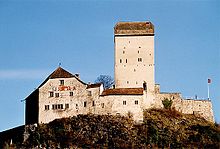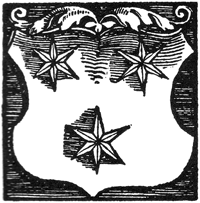Sargans county

The county of Sargans or from 1483 the bailiwick of Sargans was a historical territory in today's canton of St. Gallen in Eastern Switzerland until 1798 . The center of the county was the town and Sargans Castle . 1460–1798 formed the county of Sargans as a Landvogtei a common rule in the Old Confederation . From 1483 the federal bailiwick of Sargans was ruled by the seven federal places Uri , Schwyz , Unterwalden , Lucerne , Glarus , Zurich and Zug , from 1712 by the eight places - the aforementioned and Bern . The name “ Sarganserland ”, which was used synonymously with “Grafschaft Sargans” until 1798, has stood for a strong identity in the foothills of the Alps since the 15th century and has been preserved to this day on a political, economic and cultural level.
The blood court district of the county of Sargans originally included the rule Sargans itself, Walenstadt , Quarten and the rule Nidberg . A map of the county of Sargans and the high courts in the Sarganserland can be found in the legal sources of the Sarganserland. In 1483 the ruling seven localities of the Confederation also united the dominion of Freudenberg, i.e. the area of the Pfäfers abbey , with the county of Sargans. The lordship of Gräpplang near Flums, originally belonging to the Bishop of Chur , was owned by the Tschudi family (formerly from Glarus) from 1528 to 1767 , but was also subject to the federal bailiff in Sargans for the high court. The former county and (from 1460/1483) bailiwick of Sargans thus comprised the following municipalities today:
- Sargans
- Vilters-Wangs
- Bad Ragaz
- Pfäfers
- Mels
- Flums
- Walenstadt
- Wartau
- Quarten (only blood jurisdiction , otherwise belonging to the Windegg lordship )
history


The Counts of Werdenberg-Sargans pledged Sargans in 1396 to the Habsburg dukes of Austria, who in turn passed the pledge on to Count Friedrich VII of Toggenburg . After the death of the last Toggenburg resident, the Counts of Werdenberg-Sargans redeemed the pledge over the rule of Sargans. Walenstadt and Quarten remained with Habsburg as bailiffs. However, the residents of the country refused to recognize the Counts of Werdenberg-Sargans as their masters and in 1436 concluded castle rights with the city of Zurich . In the emerging inner-federal conflict between the city of Zurich and the rural areas of Glarus and Schwyz , the Count of Werdenberg-Sargans allied himself with Zurich's opponents. Schwyz and Glarus then conquered the Sarganserland and forced the population to take the oath of allegiance to the Count of Werdenberg-Sargans. Nevertheless, during the Old Zurich War , the count sided with the Habsburgs .
In 1458 the Counts of Werdenberg-Sargans renewed their land rights with Schwyz and Glarus. Nevertheless, the Confederates kept Walenstadt, Nidberg and Quarten, which they had conquered from the Habsburgs. In 1482/83 the last count of Werdenberg-Sargans finally sold the Sargans rule to the seven eastern towns of the Old Confederation. In 1490, the daily statute caused the construction of the old Schollbergstrasse, the first federal driveway, as a trade and military route between Sargans and Trübbach .
Thus the county had now become the bailiwick of Sargans. Looking back at the historical events of the 15th century, the change of ownership took place at a rather late point in time. The federal struggle for possession of the remote region was counteracted for a long time by obstacles and forces that made it difficult and delayed to take possession of it. The purchase in 1483 marked the end of a decades-long expansion and territorial policy of the Confederation in eastern Switzerland. The administration of the bailiwick then happened as it had been customary in the Confederation since the 15th century: as a "common" (common) subject country, it was alternately represented by a bailiff, i.e. a representative of the ruling places. Every two years, Zurich, Lucerne, Uri, Schwyz, Unterwalden, Zug and Glarus alternated; From 1712 (after the Second Villmerger War), Bern was also the eighth estate to participate in the rule. Together with the rule of Freudenberg (Pfäfers Abbey) and Walenstadt, the places formed the Landvogtei. Quarten remained part of the Common Lordship of Windegg after 1483 , but it was still subject to the blood jurisdiction of Sargans.
In 1512 the reign of Pope Julius II received a valuable « Juliusbanner » for the services rendered in the «Great Pavier Campaign» in 1508–1510 to expel the French.
A special case was the area of today's municipality of Wartau . It belonged to the County of Sargans, with the exception of the Wartau rule, which only included the Wartau Castle and the village of Gretschins . The reign of Wartau was legally closely interwoven with the rest of the area of today's municipality of Wartau, but was subject to the jurisdiction of the County of Werdenberg. When Werdenberg came to Glarus in 1517, this confused legal situation led to numerous conflicts between the bailiffs of Werdenberg and Sargans, for example in the " Wartauer Handel " of 1694/95, which was carried up to the federal diet .
In 1798 the ruling places released the County of Sargans into freedom and it constituted itself as an independent canton. Whereby the name «Canton Sargans» may not be called official, as it is usually referred to as «Canton of the former County of Sargans». The declaration of freedom by the eight old places was issued on March 3, 1798. The first and only free rural community took place on March 22, 1798 in Heiligkreuz near Mels . The previous Governor Franz Joseph Bernold was appointed President of the Provisional Government. Due to the enforced adoption of the Helvetic Constitution , this independence was terminated on June 4, 1798 when the law on the reorganization of the cantons came into force. The former county of Sargans was defeated as part of the Helvetic Republic to the reorganized canton of Linth . Through mediation , the entire former county of Sargans came to the canton of St. Gallen .
Individual evidence
- ↑ online . A map of the lower courts, which are difficult to identify, is also published online
- ↑ Winfried Hecht: The Julius banner of the town facing Rottweil. In: Der Geschichtsfreund: Messages from the Central Switzerland Historical Association . 126/7 (1973/4). doi: 10.5169 / seals-118647
- ↑ Art Monuments of the Canton of St.Gallen Volume 1, page 20
literature
- Collection of Swiss Legal Sources, XIV. Department: The Legal Sources of the Canton of St. Gallen, Part Three: The Landscapes and Country Cities, Volume 2: The Legal Sources of the Sarganserland by Sibylle Malamud and Pascale Sutter, Basel 2013 online .
- Team of authors (with numerous relevant articles on the Landvogtei Sargans): Sarganserland 1483–1983. From the county to the canton of St. Gallen. Commemorative publication for the anniversary "Sarganserland 500 years federal". Mels 1982 (period: 15th - 20th century)
- Fritz Rigendinger: The Sarganserland in the late Middle Ages: local rulers, the county of Sargans and the counts of Werdenberg-Sargans . Chronos, Zurich 2007. (Period: only until 1500!)
- Mathias Bugg: The Sargans Bailiwick in the 18th century. Lic./Master thesis University of Zurich, 2000. (Period: 18th century - with retrospectives and perspectives)
Web links
- Wolfgang Göldi: Sarganserland. In: Historical Lexicon of Switzerland .


